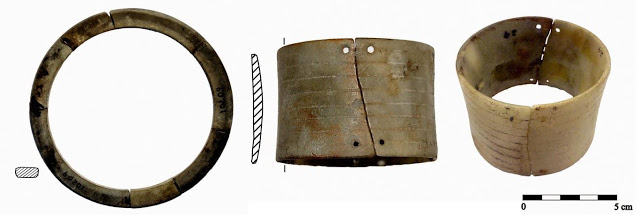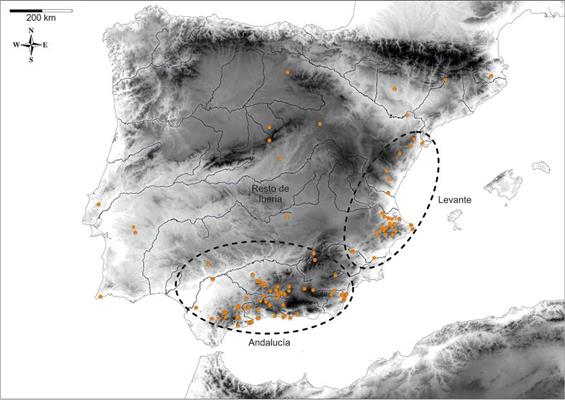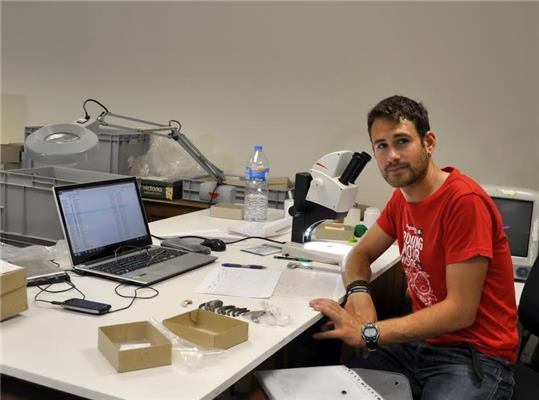

| Online: | |
| Visits: | |
| Stories: |

| Story Views | |
| Now: | |
| Last Hour: | |
| Last 24 Hours: | |
| Total: | |
7500 Year Old Stone Bracelets Shed Light on Lifestyle in Early Neolithic Communities
His pioneering work is the most comprehensive study of these ornaments, and it has served to determine that they were used both by children and adults of both sexes, and they represented a chronocultural indicator of the first Neolithic communities of Iberia.
Main types of bracelets Ancient Neolithic stone in the Iberian Peninsula. On the left, narrow type bracelet made of black limestone of the Cueva del Agua (Prado Black, Granada) and right wide bracelet decorated with parallel lines of the Cave of the Botijos (Benalmádena, Málaga).
This temporary delimitation responds to a cultural change in the Neolithic populations of southern Iberia: bracelets appeared with the emergence of the Neolithic, consolidation and peak occurs in the Old Neolithic, and their disappearance occurs during the Late Neolithic.
Map presenting the distribution of the bracelets and the different cultural areas defined by the UGR researcher
A prominent archaeological phenomenon
The use of stone bracelets is one of the most important archaeological phenomena associated with the first neolithic societies in much of the Western Mediterranean region. “In the case of Iberia, the bracelets are distributed mainly by the coastal areas, projecting inward, where the earliest and more important neolithic and cultural development in the early stages of agriculture and stock breeding occurs”, Martínez Sevilla explains.
Typological and typographic studies allowed the UGR researcher to establish, in essence, four types of bracelets: narrow, medium, wide, and decorated with parallel lines. Within each type, three groups have been defined according to the size of its inner diameter, which would be related to the individuals who used them.
Narrow bracelets are those with a more uniform geographic distribution between Andalusia and Levante (the eastern region of the Iberian Peninsula). In Andalusia, although they appear throughout the whole region, they are mainly concentrated in the Almanzora Valley and the Sierra Harana area (Granada).
Skin contact
Generally, those ornaments were mainly elaborated using indigenous materials, being marble the most valued lithology due to its physical qualities and distribution. Their functionality is evident in the traces left by their use and in anthropometric comparisons: they were used in contact with the skin for long enough to appear traces of use on the inside.
The narrow bracelets were repaired as articulated bracelets, and fragments were reused as pendants. In addition, traces of repairs show that the bracelets were used for a long time after repairing them.
“Repairs to the bracelets are more representative, in percentage, in Levante than in Andalusia, which makes us deduce that they had more social value in Levante, since they are pieces that, in most cases, were obtained by exchange. Said distinctive social value is also observed among different regions of Andalusia, given that the number of repaired parts is greater where that kind of bracelet was less frequent”, says Martínez Sevilla.
Contacts and sources:
Francisco Martinez Sevilla
Department of Prehistory and Archaeology
Citations: MARTÍNEZ-SEVILLA, F. (2016): Un adorno reflejo de una sociedad. Los brazaletes líticos del neolítico de Iberia (VI-V milenio a. C.) Tecnología, funcionalidad y circulación. Tesis doctoral inédita. Universidad de Granada.
MARTÍNEZ-SEVILLA, F. (2014):“Los contextos de producción de brazaletes de piedra neolíticos en el sur de la Península Ibérica y sus implicaciones socioeconómicas”. II Congreso de Prehistoria de Andalucía. Movilidad, Contacto y cambio. 303-313.
Source: http://www.ineffableisland.com/2016/11/7500-year-old-stone-bracelets-shed.html





